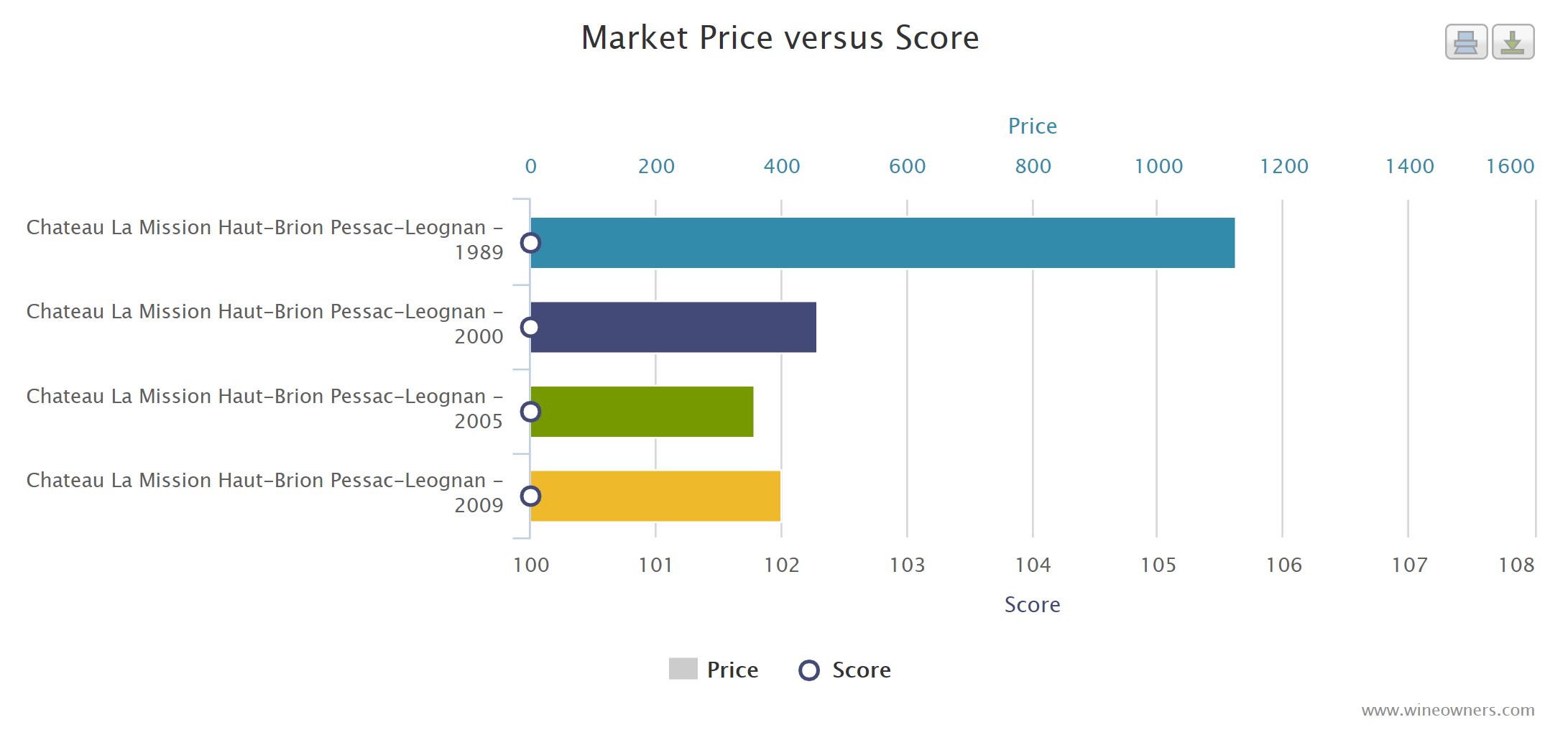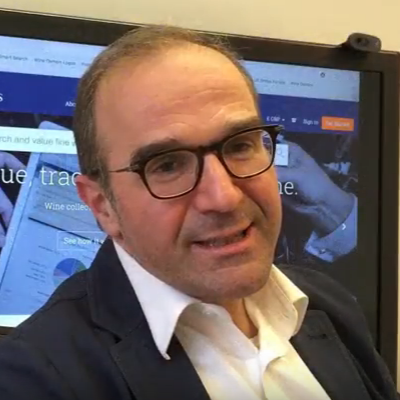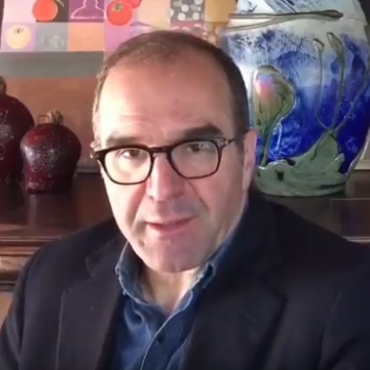by Wine Owners
Posted on 2018-05-17
An overlooked example of value for money here from the 100 point La Mission 2005. Compared to Domaine Clarence Dillon stablemate Haut-Brion, and the rest of the 2005 First Growths, 2005 La Mission is a clear winner in terms of value as is eminently clear from relative value analysis. The only other 100 point wine on the whole left bank is Haut-Brion, which trades at around £6,500. The other Mouton will cost £5,250, Latour £6,600, and Margaux £6,100, all on 98 points, while Lafite lags behind them all in relative terms, commanding £7,700 for 96 points.
Compared to other 100 point La Missions over the year, the 2005 wins out on relative value as well. Whether any of the 2009, 2005 and 2000 will hit the price highs of the legendary 1989 is a subject on which the verdict is very much out, and will depend on how reputation of the vintages develops. Nevertheless, all three look like relatively sound buys, and the 2005 at the offer price just beats the rest (assuming they can be bought at market level).

“The 2005 La Mission Haut-Brion is pure perfection. It has an absolutely extraordinary nose of sweet blackberries, cassis and spring flowers with some underlying minerality, a full-bodied mouthfeel, gorgeously velvety tannins (which is unusual in this vintage) and a long, textured, multi-layered finish that must last 50+ seconds. This is a fabulous wine and a great effort from this hallowed terroir. Drink this modern-day legend over the next 30+ years. Only 5,500 cases were produced of this blend of 69% Merlot, 30% Cabernet Sauvignon and 1% Cabernet Franc.”
100 points, Robert Parker
La Mission Haut-Brion 2005 is offered £4,300 on the Wine Owners Exchange (£4,435 including fees)
by Wine Owners
Posted on 2017-04-24

by Wine Owners
Posted on 2017-04-10
One or two commentators and one famous Bordeaux consulting oenologist are calling 2016 the best red Bordeaux vintage since 1982. Hyberbole indeed.
Bordeaux lovers and collectors have become somewhat inured to these sorts of statements. A bit like Peter, if you cry ‘wolf’ too often no one believes you when you really mean it.
Calling a vintage as a whole so early might be considered a touch reckless or over-enthusiastic, but after all that's part and parcel of the en primeur sales promotion process. It’s the wine marketing equivalent of the Oscars and it’s entirely understandable that on the back of a fine production the main actors and directors will be inclined to think their most recent performances are the best ever. New-borns are always the most miraculous and beautiful in the eyes of mesmerised parents.
But more importantly, for a vintage to be considered truly great, we think it has to be utterly consistent at a very high level across all major appellations, and ideally, relatively speaking brilliant in a number of the smaller, less grand appellations too.
2016 is not a consistently brilliant vintage across the board.
Yet Bordeaux 2016 is in many ways the perfect foil to 2015.
At Chateau Latour. Picture: Wine Owners Ltd.
Whereas 2015 was particularly strong in Margaux and Pessac-Leognan, not to mention some of the satellite right bank communes, 2016 was especially strong in St. Estephe and Pauillac.
I’d go so far to say that 2016 was the best vintage since 1982 – but only in St. Estephe. That appellation really nailed it.
Pauillac was also fabulous, possibly unsurpassed, but we also found the wines to be very consistent at an extraordinarily high level in 2010, whilst it’s hard to imagine more complete wines than the heights achieved by many in 1989. With so many great vintages already present in the Pauillac trophy cabinet, we’re going to avoid phrases such as ‘best ever’. But 2016 Pauillacs are very, very good indeed and we are truly smitten.
St Julien is a commune of great consistency once again. It’s the perennial ‘safe pair of hands’ of Bordeaux, with all the major protagonists delivering very satisfying results with great regularity. 2016 was no different: a fine result all round. Overall we think 2016 is going to be better than 2015 with greater complexity and character, and is certainly the finest since 2010 or 2005.
The bits of the Haut Medoc appellation just north of St. Estephe and south of St. Julien produced a few terrific wines in 2016 as well. But this sprawling catch-all produces 33,000,000 bottles of wines a year from 4,600 hectares and spans 29 communes across the Medoc peninsula from top to bottom, taking in the windswept mouth of the Gironde estuary to the grim warehouse agglomeration north of the city, so don't be surprised that quality is extremely variable.
Moulis and Listrac produced a few strong contenders this year too, showing none of the astringency associated with average vintages.
Margaux is a commune with a range of geographies that commonly delivers a corresponding patchwork of results. This year the wines presented as relatively bland and middle-weight, a bit of a disappointment after the stunning result achieved across the board in 2015.
Those who didn't buy Margaux in 2015 will want to revisit at some point. Nonetheless the small number of highlights were exciting to taste for their aromatic complexity and lightness of feel –consequently they are elegant, refined wines.
Chateau Margaux, framed. Picture: Wine Owners Ltd.
South of the city in Pessac-Léognan, the wines were a bit of a mixed bunch too. Some presented as truly beautiful examples of classic claret, threaded with fine acidity, moreish thanks to sherbetty fruit, but I thought 2015 was a stronger overall vintage for this large appellation, whose production has increased 3-fold in the last 40 years.
On the right bank, in St. Emilion and Pomerol the homogeneity of the vintage is less clear. I tasted less wine here, though many that I did were gorgeous: beautiful wines with up to a full percentage point less alcohol than in 2015. But others with loaded tannins left a faintly bitter fingerprint on the mid-palate, whilst a few seemed just a touch too powerful and black-hued. The impression I got is that the difficulty of the summer drought was much more evident here and there when compared with the left bank.
The summer drought was a period during when the plants shut down and compensated their lack of water by producing more tannins. The best results on the right bank will have been achieved by gentle handling of the fruit during fermentation preceded by a rigorous triage of those berries showing any signs of surmaturité.
Frédéric Faye at Chateau Figeac describes their fermentation process as an ‘infusion’ with the gentlest of extractions achieved from the submerged cap, and no pigeage. This seems to have been an ideal approach in a vintage of climatic extremes such as 2016.
Is it a coincidence that my two favourite right bank wines, Cheval Blanc and Figeac, both include cabernet sauvignon, in the case of the former, for the first time ever? On the other hand I didn’t taste the top Mouiex wines or Le Pin, which I gather all showed brilliantly, so clearly many factors, including resisting picking too early to avoid a harsh edge to the tannins, were at play in this vintage.
Generalising, 2016s show greater freshness than 2015, and so come across as more delineated and complex.
"Saint Estephe made its best wine EVER in #Bdx16". Picture: Wine Owners Ltd.
Finish is one of the most desirable attributes in a wine that is expensive and sought-after in equal measure. Acidity helps in this regard, freshening sweet, ripe fruit, lending energy to the wine, and accentuating a lingering finish. Persistence and focus are the hallmarks of 2016. Whereas 2015 right bank wines tended to a somewhat alcoholic finish, overall there’s more control to the finishes in 2016.
The balance of the best 2016s is exquisite, with a mass of ripe fruit coating the very substantial tannins of the year. The vintage’s trademark freshness makes each wine’s character more discernable, and at this stage of the wines’ evolution it’s natural to want to pick those out as personal favourites.
My favourites were also the wines that combined the vintage’s ripe briar, cassis and black cherry fruit characters with a sense of minerality and a fine line of acidity threaded through the ensemble.
Much has been said of the volume of wine produced in 2016. Production is up on 2015, but much of that comes from a very ‘hard’ and uniform fruit set that led to larger than normal bunches, i.e. with a greater number of berries per bunch than normal, but with berries of only a moderate or smaller than average size. Production volume, assumed by some to be a potentially negative factor, is a red herring in 2016.
Consequently the juice to skin ratio is no higher than normal, and 2016 has the highest ‘IPT’ numbers of any modern vintage. IPT is a measure of the combined phenolic compounds in the juice - principally tannins and anthocyanidans (colorants responsible for the red, purple and blue hues in grapes).
When all is said and done, there are plenty of exciting wines to pick from this year. I suspect many will close down with a bit of time in bottle with all that underlying structure, no matter how well resolved and integrated the tannins tasted at this early stage in a great many of the wines. Nevertheless, the tannins are generally not quite as silky as in 2015, though they are richer. 2015 may therefore turn out to be more immediately gratifying, if ultimately less exciting.
Now it’s going to be down to release prices. After all, without an obvious and sizeable price advantage for buying early, there’s little or no logic in tying up large amounts of cash on unfinished wine. It’s improbable that prices won’t increase, but those increases may be rather more patchy than normal this year appellation by appellation. And if Chateau owners can resist taking too much of the upside off the table, they may well have a winning campaign.
The Bordeaux whispers suggest an early campaign, over by the end of June, which may lead many to hope for moderation of any price increases. We shall have to wait and see.
by Wine Owners
Posted on 2017-04-05

by Wine Owners
Posted on 2017-03-28
The potential of the 2016 Bordeaux en primeur assessed from a comparative examination of the weather conditions
There is a weather station located near the airport in Bordeaux which has been recording details of rainfall and temperature since 1911. It’s worth mentioning that rain in Bordeaux-Merignac does not mean rain in St.Emilion; nor does the absence of rain in Merignac on a particular day signify no rain in Margaux. But if the 2016 Bordeaux en primeur campaign is to find traction then some consideration of the weather is important.
THE RAIN
Looking at a Table of Cumulative Precipitation (below) which covers several of the greatest vintages of the last 2 centuries (with a couple extra thrown in to demonstrate the ‘exceptions which prove the rule’), one is immediately struck by one anomaly - the 1982 vintage (the others we know about).
It is a sine qua non of red wine grape production to have a sufficient period of dry weather in the summer to induce hydric stress in the vine so that the plant will cease growth and focus on maturing its fruit. It’s also a general rule that wet weather at harvest time is not conducive to healthy picking conditions and produces rot.
Table of Cumulative Precipitation
THE HEAT
It is widely accepted that warm weather (as opposed to canicular heat - remember that 2003 had 50 days of temperatures warmer than 30°) is another critical ingredient in the production of great wine (also interesting to see just how much cooler it was in 1982) - see the table below of Maximum Average Temperatures.
Maximum Average Temperatures
Clearly, the temperature progression during 2016 was unusual and extraordinary. Not shown, but also relevant, is a table constructed of average minimum temperatures: 2016 was about average, and slightly cooler than many other years in July; certainly not as warm as 2003.
ASSESSMENT OF BORDEAUX 2016 VINTAGE
Whilst the general weather picture for a vintage is a good prognostication of the quality of the wines not everyone will have been dealt the same cards. Terroirs are not the same. Not every estates’ ambitions are equivalent. Not every vigneron has the tools, techniques and vision to maximise the potential. Some producers will undoubtedly over-reach themselves. Comparing the general climatic conditions for 2016 with other remarkable vintages several features of the 2016 Bordeaux vintage stand out:
- First, 2016 had no phenomenological events of any significance eg frost.
- Second, the precipitation in the growing season and replenishment of the water table set it up for drier conditions later in the year. Of course, warmer humid weather at this time meant vigilance in case of mildew etc.
- Third, the uniformity of temperatures and the progression of average temperatures until August, without the heat spikes of 2003.
- Fourth, August was an unusually sunny month in 2016.
- Fifth: the dry, warm months of July and August were followed by a beautiful autumn.
On the face of it, the charts above, general as they are, demonstrate that 2016 was one of the most remarkable years that Bordeaux vineyards have ever experienced. One might, with some justification, call it a ‘benchmark’ year. Coupled with the advancement in oenology and the investment in First floors which have been undertaken in the last 30 years and if meteorology were the only factor in determining vintage quality (so ignoring viticultural practises, key husbandry decisions, winemaking approaches and trends, sharp temperature spikes masked by monthly averages) then 2016 could be one of the greatest, if not the greatest of Bordeaux vintages. However, the true quality of the vintage will only be demonstrated by the en primeur tastings which are about to commence.
Estates are surely crying (with happiness) over their wines and as for the rest of us, to paraphrase Goethe: “If you've never drunk wine while crying, you don’t know what life tastes like.”
Stay with Wine Owners as we taste our way through the Bordeaux appellations next week. Follow our tweets @WineOwners1. As ever we shall represent the voice of the wine lover and collector pointing out where there's value and where it makes no sense to buy early. Not forgetting the merits in back vintages that en primeur comparative evaluation often spotlights. We look forward to your company along the way.
Tables: compiled and coloured by Wine Owners from data by Infoclimat

